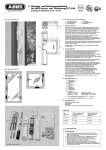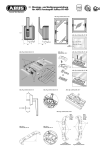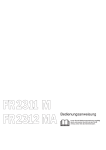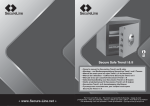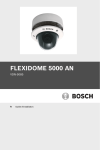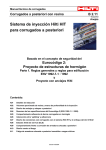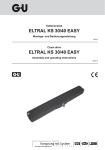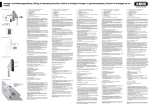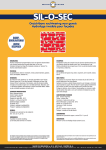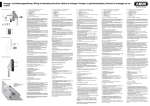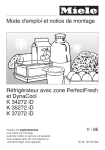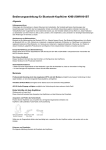Download Montageanleitung FAS101
Transcript
Montageanleitung FAS101 classificatie manuele test inbraakwerendheidsklasse contacttijd/ NEN5096/ENV1630 gereedschapsset zelfstandig RC 2 gebruik BA-anker houten kozijnen Abb./fig./schéma/ afb./ill. 1a 3 min. / A Abb./fig./schéma/ afb./ill. 1b kunststof kozijnen zonder ABUS bevestigingsanker in combinatie met ABUS bevestigingsanker D Diese Anleitung ist wie folgt untergliedert: I. Allgemeine Hinweise II.Einsatzmöglichkeit III.Packungsinhalt „1“ 24 mm „2“ 32 mm IV. Werkzeug V. Montageanleitung VI.Bedienung I. Allgemeine Hinweise Die Fenster-Scharnierseiten-Sicherung FAS101 ist nach DIN 18104-1 und VdS 2536 anerkannt. Durch DIN Certco ist FAS101 zertifiziert „EINBRUCH- HEMMEND DIN-geprüft“. FAS101 bietet zusätzlich Schutz gegen unberechtigtes Eindringen in ihre Räume. Gemäß DIN 18104-1 wird empfohlen, dass pro 1 Meter Fensterhöhe rechts und links jeweils eine Zusatzsicherung montiert wird (pro Fenster). Polizei und Versicherer empfehlen dieses ebenfalls. 69 123 54 Die optimale Schutzwirkung erreichen Sie, wenn Sie entsprechend dieser Montageund Bedienungsanleitung vorgehen. Die Befestigungsschrauben sollten zur Vermeidung von Überdrehung mit einem geeigneten Werkzeug eingeschraubt und von Hand angezogen werden. Ausschließlich ABUS-Befestigungsmaterial einsetzen. Für eventuell auftretende Verletzungen bzw. Schäden, die bei der Montage und/ oder durch unsachgemäße Handhabung entstehen, übernimmt der Hersteller keine Haftung! Ein Zugang des gesamten Objektes muss von außen mittels Schlüssel zu öffnen sein. II. Einsatzmöglichkeit 19 min. 10 Abb./fig./schéma/ afb./ill. 2 „1“ max. 6,5 „2“ max. 14 FAS101 wird grundsätzlich auf der Innenseite montiert, das Flügelblech auf dem Fensterflügel und die Rahmenleiste auf dem Rahmen. min. 10 Bei schlechten Befestigungsmöglichkeiten (Weichholz- oder Kunststofffenster) sollten mehrere Sicherungen und zusätzlich Befestigungsmittel (Befestigungsanker oder Verbundmörtel) eingesetzt werden. Hierzu verwenden Sie bitte den ABUS-Befestigungsanker BA (Kunststoff-, Weichholz-, Alufenster) oder alternativ das ABUS-Befestigungsset IM100 (Kunststofffenster). Zu IM 100 benötigen Sie einen geeigneten Verbundmörtel, z.B. der Marke Fischer FIS VS 150C, Hilti HFX oder ein ähnliches Produkt. ABUS BA und ABUS IM 100 sowie Verbundmörtel sind im Handel erhältlich. FTS FAS Abb./fig./schéma/ afb./ill. 2 FTS Die in Abb. 2 zusätzlich gezeigten ABUS-Produkte (FTS) sind ebenfalls im Handel erhältlich. III. Packungsinhalt (Abb. 3) FAS FAS FTS 1. 1 Rahmenleiste 2. 1 Führungshülse 3. 1 Druckstift 4. 1 Clip 5. 1 Riegelbolzen 6. 1 Feder 7. 2 x Flügelblech (1+2) 8. 1 Flügelhaube 9. 1 Rahmenhaube 10.Schrauben: 1 Stück 5,5 x 50 mm, 2 Stück 3,5 x 25 mm, 2 Stück 4,8 x 50 mm, 3 Senkschrauben 4,8 x 50 mm, 2 Stück 3,5 x 13 mm, 1 Senkschrauben 4,8 x 22 mm 11.1 Satz Unterlagen für Flügelblech je 1x1, 2, 3, 4, 8 mm 12.1 Satz Unterlagen für Rahmenleiste je 1x1, 2, 4 mm FTS Abb./fig./schéma/ afb./ill. 3 8 10 IV. Montagewerkzeug 11 3 · Kreuzschlitzschraubendreher · Bohrmaschine · Metermaß · Feile, Säge zum Kürzen der Schrauben, ggf. Schraubstock 12 1 FAS101 wird auf der Scharnierseite des Fensters oder der Fenstertür montiert und eignet sich für alle gängigen nach innen öffnende Fenster/Fenstertüren mit Einhand Dreh- oder -Dreh-Kipp-Beschlägen (Abb. 1a+b). Der Falzstärke entsprechend muss entweder das Flügelblech 1 oder 2 (7) eingesetzt werden. Die Montage kann auf den Werkstoffen Kunststoff, Holz oder Alu erfolgen. Die Fenster/Fenstertüren können nach rechts oder links öffnen. Wahlweise kann die Betätigung der FAS101 von oben oder unten erfolgen. Die Montage ist für Betätigung von unten beschrieben. 9 2 5 7 6 4 www.abus.com Fitting instructions | Instructions de montage FAS101 G These instructions are organised in the following sections: F Ce manuel comporte les chapitres suivants: I. General instructions II. Possible uses III. Pack contents I. Conseils d’ordre général IV. Outillage II. Application V. Instructions d’installation III. Liste de colisage VI. Utilisation IV. Tools V. Installation instructions VI. Operation I. General instructions I. Conseils d’ordre général The window hinge security device FAS101 is recognised as complying with the strict test requirements of DIN 18104-1 and VdS 2536. FAS101 is certified by DIN Certco as “BURGLAR RETARDANT DIN tested”. FAS101 offers additional protection from unauthorised intruders in your rooms. DIN 18104-1 recommends that an additional security device should be fitted on the left and right for every meter in height (per window). The police and insurance companies also give the same recommendation. La sécurité pour gonds de fenêtre FAS101 satisfait aux exigences de contrôle sévères des normes DIN 18104-1 et VdS 2536. Le certificat DIN indique que FAS101 a obtenu la qualification «anti-effraction DIN». FAS101 offre en plus une protection contre les intrusions par effraction dans votre logement. Selon la norme DIN 18104-1, il est recommandé de monter une sécurité complémentaire par mètre de hauteur de fenêtre, à gauche comme à droite. La police et les compagnies d’assurance le recommandent également. Optimum protection can be achieved by proceeding according to these installation and operation instructions. To prevent the risk of overtightening, the fastening screws should by screwed in using a suitable tool and tightened by hand. Only use ABUS fastening material. The manufacturer does not assume any liability for possible injuries or damages caused during installation and/or by incorrect handling! II. Possible use FAS101 is mounted on the hinge side of the window or French door and is suitable for all common windows/French doors opening to the inside with turn or turnand-tilt hardware (fig. 1a+b). Depending on the rebate, casement plate 1 or 2 (7) has to be used. The lock can be fitted to wood, PVC or aluminium. The windows/ French doors can open to the right or left. The security device FAS101 can be activated from top or bottom. The described installation procedure is for activation from the bottom. FAS101 is always mounted to the inside, with the casement plate on the window casement and the frame strip on the frame. In poor fixture conditions (soft or hollow or foam base and PVC windows with and without metal inlay and wooden windows) and/or good possibilities for intrusion from the outside, more security devices and additional fastenings should be used (composite mortar or fixing bolts). If the frame itself is too weak for sensible retrofitting, it may be necessary for example to reinforce the frame. Pour un effet de protection optimal, suivez les instructions de ce manuel d’installation et d’utilisation. Afin d’éviter un serrage abusif, vissez et serrez les vis de fixation à la main et avec un outillage adéquat. Utilisez exclusivement des accessoires ABUS. Le fabricant n’assume aucune responsabilité pour d’éventuels blessures ou dégâts causés pendant l’installation et/ou par suite de manipulations inappropriées! L’ensemble doit être accessible de l’extérieur afin de l’ouvrir au moyen d’une clé. II. Application FAS101 est monté sur le côté des paumelles de la fenêtre ou de la porte-fenêtre et convient pour toutes les fenêtres/portes-fenêtres courantes, ouvrant vers l’intérieur et pourvues de quincaillerie ouvrante ou oscillo-battante avec commande d’une seule main (schéma 1a+b). Suivant l’épaisseur du recouvre-ment de la porte, utiliser l’ailette en tôle N° 1 ou 2 (7). L’installation peut être effectuée sur des cadres en bois, en PVC ou en aluminium. Les fenêtres/portes-fenêtres peuvent s’ouvrir à gauche ou à droite. La commande de FAS101 peut être effectuée par le haut ou par le bas. L’installation décrite correspond à une commande par le bas. FAS101 est monté en principe du côté intérieur, la platine d’ancrage sur l’ouvrant et le socle de fixation sur le dormant. The ABUS products also shown in fig. 2 (FTS) are also available from retail stores. En cas de possibilités de fixation défavorables (fenêtres en bois ou en PVC), plusieurs sécurités et des fixations supplémentaires (ancre de fixation ou mortier) doivent être prévues. Pour cela, utilisez l’ancre de fixation ABUS BA (pour fenêtres en PVC, en bois tendre ou en aluminium) ou l’ensemble de fixations ABUS IM 100 (pour fenêtres en PVC). Pour IM 100, un mortier de fixation approprié est requis, par exemple FIS VS 150C de la marque Fischer, HFX de la marque Hilti ou un produit similaire. ABUS BA et ABUS IM 100 ainsi que le mortier de fixation sont disponibles dans le commerce. Les produits ABUS complémentaires illustrés en schéma 2 (FTS) sont également disponibles dans le commerce. III. Pack contents (fig. 3) III. Liste de colisage (schéma 3) 1. 1 frame strip 2. 1 guide sleeve 3. 1 pressure pin 4. 1 clip 5. 1 locking bolt 6. 1 spring 7. 2 x casement plate (1+2) 8. 1 casement cover 9. 1 frame cover 10.Screws: 1 each 5.5 x 50 mm, 2 each 3.5 x 25 mm, 2 each 4.8 x 50 mm, 3 countersunk screws 4.8 x 50 mm, 2 each 3.5 x 13 mm, 1 countersunk screws 4.8 x 22 mm 11.1 set of shims for casement plate, 1 x 1, 2, 3, 4, 8 mm each 12.1 set of shims for frame strip, 1 x 1, 2, 4 mm each 1. 1 socle de fixation 2. 1 tuyau de guidage 3. 1 tige d’appui 4. 1 circlip 5. 1 pêne de verrouillage 6. 1 ressort 7. 2 x platine d’ancrage (1+2) 8. 1 cache pour platine 9. 1 cache pour socle 10.Vis: 1 pièce de 5,5 x 50 mm, 2 pièces de 3,5 x 25 mm, 2 pièces de 4,8 x 50 mm, 3 vis à tête conique de 4,8 x 50 mm, 2 pièces de 3,5 x 13 mm, 1 vis à tête conique de 4,8 x 22 mm 11.1 ensemble d’entretoises pour platine d’ancrage chacun 1x1, 2, 3, 4, 8 mm 12.1 ensemble d’entretoises pour socle de fixation chacun 1x1, 2, 4 mm To do so, please use the ABUS fixing bolt BA or alternatively for PVC frames, the ABUS fastening set IM 100. For IM 100 you need a suitable composite mortar, e.g. Fischer FIS VS 150C or similar. ABUS BA and ABUS IM 100 are available from retail stores together with composite mortar. IV. Installation tools · Phillips screwdriver · Drill · Yardstick · Saw, file for shortening the screws, possibly vice IV. Outillage requis · Tournevis cruciforme · Perceuse · Mètre ruban · Lime, scie pour raccourcir les vis, tournevis www.abus.com Montagehandleiding | Istruzioni per il montaggio FAS101 n Deze gebruiksaanwijzing is als volgt onderverdeeld: I Queste istruzioni si suddividono nel modo seguente: I. Algemeen II. Toepassing III. Verpakkingsinhoud I. Istruzioni generali IV. Attrezzi II. Possibilità d’impiego V. Istruzioni di montaggio III. Contenuto della confezione VI. Uso IV. Gereedschap V. Montage VI. Bediening I.Algemeen I. Istruzioni generali Scharnierbeveiliger FAS101 voor naar binnen draaiende draai/kiep elementen. FAS101 is volgens keuringseisen NEN 5096 SKG gecertificeerd. La sicura per cerniere di finestre FAS101 è conforme ai severi requisiti di controllo della DIN 18104-1 e della VdS 2536. Con la DIN Certco essa è certificata come «ANTISCASSO conf. DIN». La FAS101 garantisce una protezione in più a difesa della Vostra casa. Secondo DIN 18104-1 si consiglia di montare per ogni metro di altezza della finestra, una sicura supplementare sul lato destro e una sul lato sinistro (per ogni finestra). Anche la polizia e le compagnie d’assicurazione consigliano tali misure. De FAS101 biedt daarnaast bescherming tegen onbevoegd binnendringen van uw woning. Advies: monteer aan de scharnierzijde voor maximale veiligheid 2 stuks per 1 meter raamhoogte. Op kunststof zonder metalen kern dient u deze scharnierbeveiliger in combinatie met ABUS BA bevestigingsanker te monteren. Optioneel verkrijgbaar, zie voor montage in de handleiding van BA. Optimale veiligheid wordt bereikt door nauwkeurig opvolgen van deze montage- en gebruiksaanwijzing. Om overexpansie of doldraaien van de bevestigingsschroeven te vermijden, draait u handmatig en met passend gereedschap de schroeven vast. Si può ottenere una protezione ottimale, procedendo secondo queste istruzioni di montaggio ed uso. Le viti di fissaggio, per evitarne un serraggio eccessivo, devono essere avvitate con un utensile adatto e poi serrate a mano. Impiegare esclusivamente materiale di fissaggio ABUS. Voor eventueel verwondingen en/of schade tijdens montage en/of door ondeskundig gebruik ontstaan, aanvaardt de fabrikant geen aansprakelijkheid! Per eventuali ferimenti e/o danni, che si verificano durante il montaggio e/o per maneggio indebito, il produttore non si assume alcuna responsabilità! II. Toepassing II. Possibilità d’impiego De FAS101 wordt aan de scharnierzijde gemonteerd en is geschikt voor alle naar binnen draaiende ramen en deuren met draai/kip-beslag (afb. 1a+b). Afhankelijk van de opdekhoogte moet raamplaat 1 of 2 (7) toegepast worden. Montage mogelijk op hout, kunststof of aluminium. Rechts of links draaiend. Hoewel de bediening van de vergrendeling van onder- of van bovenaf plaats kan vinden wordt in deze montage- en bedieningsinstrictie uitgegaan van een bediening van onderaf. La FAS101 viene montata sul lato della cerniera della finestra o della porta-finestra ed è adatta per tutte le normali finestre e porte-finestre che si aprono verso l’interno, con guarnizioni metalliche girevoli o girevoli a bilico (ill. 1a+b). Secondo losspessore della finestzra si posa la lamierina 1 o 2 (7). Si può montare la FAS101 su legno, plastica o alluminio. Le finestre/porte-finestre possono aprirsi verso destra o verso sinistra. A scelta la FAS101 si può azionare dall’alto o dal basso. Il montaggio è descritto per azionamento dal basso. Di solito la FAS101 viene montata all’interno, la lamiera del battente sul battente della finestra ed il listello del telaio sul telaio. De FAS101 wordt uitsluitend aan de binnenzijde gemonteerd; de raamplaat op het raam of deur en de kozijnlijst op het kozijn. Bij slechte bevestigingsmogelijkheden (zacht hout of kunststof) dienen meerdere sloten en extra bevestigingsmiddelen (bevestigings- of chemische ankers) toegepast te worden. Hiervoor kunt u het ABUS bevestigingsanker BA (zacht hout, kunststof, aluminium) of als alternatief de ABUS bevestigingsset IM 100 (kunststof) gebruiken (in schroefgat D). Bij IM 100 heeft u een passend chemisch anker nodig, bijv. Fischer FIS VS 150C, Hilti HFX of vergelijkbaar. ABUS BA, IM 100 en chemische ankers zijn in de handel verkrijgbaar. De in afb. 2 extra getoonde ABUS producten (FTS) zijn eveneens in de handel verkrijgbaar. III. Verpakkingsinhoud (afb. 3) 1. 1 kozijnlijst 2. 1 geleidingshuls 3. 1 drukstift 4. 1 clip 5. 1 vergrendelingspen 6. 1 veer 7. 2 x raamplaat (1+2) 8. 1 raamplaat-afdekkap 9. 1 kozijnlijst-afdekkap 10.Schroeven: 1 stuks 5,5 x 50 mm, 2 stuks 3,5 x 25 mm, 2 stuks 4,8 x 50 mm, 3 stuks 4,8 x 50 mm met verzonken kop, 2 stuks 3,5 x 13 mm, 1 stuks 4,8 x 22 mm met verzonken kop 11.1 set opvulplaatjes voor raamplaat 1x1, 2, 3, 4 en 8 mm 12.1 set opvulplaatjes voor kozijnlijst 1x1, 2 en 4 mm IV. Gereedschap · Kruiskopschroevendraaier · Boormachine · Meetlat · Zaag, vijl en eventueel bankschroef voor het inkorten van de schroeven Se le possibilità di fissaggio sono scadenti (sottofondo morbido o vuoto o riempito con espanso e finestre in plastica con o senza inserto metallico e finestre in legno) e le possibilità di effrazione dall’esterno sono buone, si dovrebbero utilizzare più sicure e mezzi di fissaggio supplementari (malta o avvitamento passante o bullone di fissaggio). Se i telai stessi sono troppo deboli, per poterli allestire adeguatamente in un secondo tempo, potrebbe essere consigliabile rinforzare, per esempio, i telai stessi. Allo scopo utilizzare per favore il bullone di fissaggio ABUS BA o come alternativa, nel caso di telai in plastica, il kit di fissaggio ABUS IM 100. Per il IM 100 serve una malta adatta, p.e. della marca Fischer FIS VS 150C o un prodotto simile. ABUS BA e ABUS IM 100 come anche la malta si possono acquistare. Anche i prodotti ABUS (FTS) raffigurati nel’ill. 2 (FTS) si possono acquistare. III. Contenuto della confezione (ill. 3) 1. listello del telaio 2. boccola di guida 3. 1 perno di spinta 4. 1 clip 5. 1 perno del chiavistello 6. 1 molla 7. 2 x lamierina (per battente) (1+2) 8. 1 coperchietto della lamierina per battente 9. 1 coperchietto per listello del telaio 10.Viti: 1 vite da 5,5 x 50 mm, 2 viti da 3,5 x 25 mm, 2 viti da 4,8 x 50 mm, 3 viti a testa svasata da 4,8 x 50 mm, 2 viti da 3,5 x 13 mm, 3 viti a testa svasata da 4,8 x 22 mm 11.1 kit di spessori per ogni lamierina del battente, ciascuno 1 x 1, 2, 3,4,8 mm 12.1 kit di spessori per ogni listello del telaio ciascuno 1x1, 2, 4 mm IV. Attrezzi da montaggio · Cacciavite a stella (con punta magnetica) · Trapano · Sega, lima per accorciare le viti, in caso una morsa www.abus.com Montageanleitung FAS101 Abb./fig./schéma/ afb./ill. 4 Abb./fig./schéma/ afb./ill. 5 Riegelbolzen Locking bolt Pêne de verrouillage Vergrendelingspen Perno del chiavistello Rahmenleidte Frame strip Platine de fixation Kozijnlijst Listello del telaio A B A Bohrtabelle Für Schrauben Ø In Holz und Kunststoff ohne Metalleinlage Bohrer Ø In Alu und Kunststoff mit Metalleinlage Bohrer Ø 5,5 mm 4 mm 4,5 mm 4,8 mm 3,5 mm 3,5 mm 3,5 mm 2,5 mm 3 mm V. Montageanleitung: Wichtige Hinweise: · Vor der Montage prüfen Sie bitte die Einstellung des Fensters. Stellen Sie sicher, dass sich das Fenster/die Fenstertür einwandfrei öffnen und schließen lässt. · Messen Sie auch nach, ob die in Abb. 1a+b angegebenen Maße an Ihrem Fenster/ Ihrer Fenstertür vorhanden sind. · Die Bohrlochtiefen bzw. die Schraubenlängen müssen auf die örtlichen Gegebenheiten abgestimmt werden, ebenso die empfohlene Schrägverschraubung bei Holzfenstern. · Austreten des Bohrers bzw. der Schrauben auf der Rückseite vermeiden! Ggf. mit Bohranschlag arbeiten oder die vorhandenen Schrauben kürzen. Beim Bohren keine beweglichen Teile, Dichtungen oder Glasscheiben verletzen. Montage: Abb./fig./schéma/ afb./ill. 6a Abb./fig./schéma/ afb./ill. 7 Abb./fig./schéma/ afb./ill. 8 Abb./fig./schéma/ afb./ill. 6c Abb./fig./schéma/ afb./ill. 6b Abb./fig./schéma/afb./ill. 9 Abb./fig./schéma/afb./ill. 10 Falls die Flügelhaube (8) und Rahmenhaube (9) montiert sind,diese zunächst vorsichtig abnehmen. 1. Riegelbolzen (5) mit dem langen Ende voran in Rahmenleiste (1) stecken, an das vorhandene Fensterscharnier halten (Abb. 4), so dass der Mittelpunkt des Riegelbolzens (5) mit der Drehachse des oberen und unteren Scharniers übereinstimmt (± 1 mm erlaubt). Rahmenleiste (1) ggf. mit Unterlagen (12) ausgleichen. 2. Abstand (X) der Rahmenleiste (1) zum Fensterflügel messen; Hilfsmittel: Unterlagen (Abb. 5). 3. R iegelbolzen (5) entnehmen. Rahmenleiste (1) auf gewünschte Montageposition bringen und darauf achten, dass der ermittelte Abstand (X) zum Fensterflügel (Drehachse) genau eingehalten wird (Abb. 5). 4. Bohrlöcher A + B anzeichnen und vorbohren (s. Bohrtabelle). Rahmenleiste (1) ggf. mit den Unterlagen (12) mit Schrauben A = 5,5x 50 mm, B = 4,8 x 50 mm handfest anschrauben. 5. Druckstift (3) von oben in die Führungshülse (2) so einsetzen (Abb. 6a), dass der Druckstift (3) unten ca. 30 mm aus der Führungshülse (2) herausragt (Abb. 6b), ggf. mehrmals etwas drehen. Riegelbolzen (5) mit dem breiten Ende voraus in die Führungshülse (2)einschieben und Feder (6) aufstecken (Abb. 6c). 6. Komplette Einheit von unten enganliegend in die Rahmenleiste (1) über den Widerstand der Blattfeder hinaus einschieben. Druckstift (3) nicht eindrücken (Abb. 7). 7. C lip (4) auf die Führungshülse (2) drücken, so dass der Clip (4) rechts und links in die Rahmenleiste (1)einrastet (Abb. 8). Rahmenhaube (9) von unten über den Druckstift (3) auf die Rahmenleiste (1) stecken und fest andrücken. Fenster öffnen und überprüfen, ob beide Seiten des Clips fest eingerastet sind. 8. Flügelblech (7)in die Rahmenleiste (1) einsetzen und ggf. mit Unterlagen (11) ausgleichen. Druckstift (3) eindrücken, so dass die FAS101 verriegelt ist. Flügelblech (7) mittig ausrichten und Bohrlöcher C anzeichnen und mittig vorbohren (Abb. 9) (s. Bohrtabelle). Je nach Dicke des Unterlagenpaketes (11) Flügelblech (7) mit Schrauben 3,5 x 13 mm bzw. 3,5 x 25 mm handfest anschrauben. Funktion des Fensters überprüfen. Schließen und öffnen, ggf. nachjustieren. Schraublöcher D vorbohren (Abb. 9) (s. Bohrtabelle). Bei Holzfenstern die beiden vorderen Löcher leicht schräg, bis max. 20° Neigung Richtung Fenstermitte vorbohren. Hinweis: Bei umlaufenden Fensterbeschlägen beim Bohren des mittleren Schraubloches D nicht das Fenstergetriebe beschädigen. 9. F lügelblech (7) anschrauben: Bei Fenstern ohne umlaufenden Beschlag mit 3 Schrauben 4,8 x 50 mm. Bei Fenstern mit umlaufendem Beschlag mit 2 Schrauben 4,8 x 50 mm und 1 Schraube 4,8 x 22 mm beim mittleren Schraubloch D. 10. Flügelhaube (8) aufdrücken (Abb. 10). VI. Bedienung · FAS101 wird in die normale Betätigung des Fensters einbezogen. · In geschlossenem Zustand des Fensters Druckstift generell eindrücken bis er einrastet. Für normale Drehöffnung ist keine weitere Betätigung notwendig. · Zum Kippen des Fensters Druckstift nach dem Kugelschreiberprinzip ausrasten, sodass er ca. 30 mm herausfährt. · Nach dem Schließen des Fensters Druckstift wieder eindrücken bis er einrastet. Technische Änderungen vorbehalten. Für Irrtürmer und Druckfehler keine Haftung. www.abus.com Fitting instructions | Instructions de montage FAS101 Drilling table Tableau de perçage For screws Ø In wood and PVC without metal inlay drill bit Ø in aluminium and PVC with metal inlay drill bit Ø pour vis de Ø dans châssis bois et PVC sans armature métalique foret Ø dans châssis aluminium et PVC avec armature métallique foret Ø 5,5 mm 4 mm 4.5 mm 5,5 mm 4 mm 4,5 mm 4.8 mm 3.5 mm 3.5 mm 4,8 mm 3,5 mm 3,5 mm 3.5 mm 2.5 mm 3 mm 3,5 mm 2,5 mm 3 mm V. Installation instructions: V. Instructions de montage: · Before installation, please check the setting of the window or French door. · If necessary, readjust the fittings so that the window (French door) opens and closes perfectly. · Also check whether your window/French door complies with the dimensions shown in fig. 1a+b. · The depths of the drilled holes and screw lengths must be adjusted to the local conditions, also the recommended angled screw connection wooden windows. · Avoid the drill or screws from coming out at the back! Possibly work with drill stopper or shorten the existing screws. · When drilling, do not damage any moving parts, seals or glass panes. Indications importantes: · Avant l’installation, contrôlez l’ouverture de la fenêtre. Assurez-vous que la fenêtre/porte-fenêtre ouvre et ferme parfaitement. · Vérifiez si votre fenêtre/porte-fenêtre comporte les dimensions indiquées en schéma 1a+b. · Les profondeurs de perçage ou plutôt les longueurs des vis ainsi que les pas de vis en biais sur les fenêtres en bois doivent être adaptées aux conditions locales. · Evitez le dépassement de perçage ou de vis sur la face arrière! Le cas échéant, utilisez une butée de perçage ou raccourcissez les vis de fixation. · Lors du perçage, évitez d’endommager les éléments mobiles, les joints ou les vitres. Installation: If the casement cover (8) and frame cover (9) are fitted, remove them carefully first. 1. Push the locking bolt (5) into the frame strip (1) with the long end first, hold against the existing window hinge (fig. 4) so that the middle point of the locking bolt (5) corresponds to the turning axis of the upper and lower hinge (± 1 mm allowed). If necessary, use shims (12) to adjust the frame strip (1). 2. Measure the distance (X) of the frame strip (1) to the window casement (aid: shims). 3. Take the locking bolt (5) out. Apply the frame strip (1) in the required fitting position, keeping exactly to the measured distance (X) to the window casement (turning axis) (fig. 5). 4. Mark and pre-drill holes A and B (see drilling table). Screw frame strip (1) hand tight possibly with the shims (12), using screws A = 5.5 x 50 mm, B = 4.8 x 50 mm. 5. Insert the pressure pin (3) into the guide sleeve (2) from above (fig. 6a) so that the pressure pin (3) protrudes approx. 30 mm from the guide sleeve (2) (fig. 6b), possibly turning several times. Push the locking bolt (5) into the guide sleeve (2) with the wide end first and put the spring (6) in position (fig. 6c). 6. Push the whole unit from below into the frame strip (1) in a tight fit over and beyond the resistance of the leaf spring. Do not press pressure pin (3) in (fig. 7). 7. P ush the clip (4) onto the guide sleeve (2) so that the clip (4) engages in the frame strip (1) on the right and left (fig. 8). Push the frame cover (9) over the pressure pin (3) from below onto the frame strip (1) and press on firmly. Open the window and check whether both sides of the clip have engaged firmly. 8. Insert the casement plate (8) in the frame strip (1) and line with shims (11) if necessary. Press the pressure pin (3) in so that FAS101 is locked. Align casement plate (7) centrally; mark and pre-drill holes C in the middle (fig. 9): (see drilling table). Depending on the thickness of the shim package (11), screw the casement plate (7) on hand tight using screws 3.5 x 13 mm resp. 3.5 x 25 mm. Check that the window functions: Close and open, adjust if necessary. Pre-drill screw holes D (fig. 9) (see drilling table). On wooden windows pre-drill the two front holes slightly at an angle, up to max. 20° in the direction of the window center Note: For peripheral window hardware, do not damage the window gear when drilling the middle screw hole D. 9. Screw on the casement plate (7): for windows without peripheral hardware, use 3 screws 4.8 x 50 mm. For windows with peripheral hardware, use 2 screws 4.8 x 50 mm and 1 screw 4.8 x 22 mm in middle hole D. 10. Press on the casement cover (8) (fig. 10). VI. Operation · FAS101 is integrated in the normal operation of the window. · When the window is closed, generally press the pressure pin until it engages. No other operation is required when turning the window open normally. · To tilt the window, release the pressure pin using the “ballpoint pen” principle so that it comes approx. 30 mm out. · After closing the window, press the pressure pin in again until it locks. Rights to make technical changes reserved. No liability for mistakes and isprints. Installation: Si le cache pour platine (8) et le cache pour socle (9) sont montés, déposez-les avec précaution. 1. Insérez le pêne de verrouillage (5) avec le côté allongé vers l’avant dans le socle de fixation (1) et maintenez-le contre la paumelle existante (schéma 4), de façon à ce que l’axe médian du pêne de verrouillage (5) soit aligné sur l’axe de pivotement des paumelles supérieure et inférieure (tolérance de ± 1 mm). Ajustez le socle de fixation (1) au moyen des entretoises (12). 2. Mesurez la distance (X) entre le socle de fixation (1) et l’ouvrant. Aides: entretoises (schéma 5). 3. Retirez le pêne de verrouillage (5). Placez le socle de fixation (1) à la position désirée en prenant soin de maintenir avec précision la distance mesurée (X) par rapport à l’ouvrant (axe de pivotement) (schéma 5). 4. Tracez et préforez les positions de perçage A et B (voir tableau de perçage). Fixez le socle de fixation (1) au moyen des vis A = 5,5 x 50 mm, B = 4,8 x 50 mm et éventuellement des entretoises (12) et serrez à la main. 5. Insérez la tige d’appui (3) par le haut dans le tuyau de guidage (2) de telle façon (schéma 6a), qu’elle dépasse du bas du tuyau (2) d’environ 30 mm (schéma 6b), en la faisant éventuellement pivoter à plusieurs reprises. Insérez le pêne de verrouillage (5) avec l’extrémité large vers l’avant dans le tuyau de guidage (2) et montez le ressort (6) (schéma 6c). 6. Insérez l’ensemble complet par le bas dans le socle de fixation (1) en comprimant le ressort. N’enfoncez pas la tige d’appui (3) (schéma 7). 7. Posez le circlip (4) sur le tuyau de guidage (2), de façon à ce qu’il s’engage à gauche et à droite dans le socle de fixation (1) (schéma 8). Posez et clipsez le cache pour platine (9) par-dessus l’extrémité inférieure de la tige d’appui (3) sur le socle de fixation (1). Ouvrez la fenêtre et contrôlez si les deux côtés du circlip sont fermement engagés. 8. Placez la platine d’ancrage (7) dans le socle de fixation (1) et ajustez-le éventuellement au moyen des entretoises (11). Enfoncez la tige d’appui (3), de façon à verrouiller FAS101. Alignez la platine de fixation (7) au centre et tracez les centres de perçage C puis préforez (schéma 9) (voir tableau de perçage). Fixez la platine de fixation (7) à la main avec des vis de 3,5 x 13 mm ou de 3,5 x 25 mm en fonction de l’épaisseur des entretoises (11). Contrôlez le bon fonctionnement de la fenêtre. Ouvrez et fermez la fenêtre et ajustez le cas échéant. Pré-percer les fixations des vis D (schéma 9) (voir tableau de perçage). Sur des fenêtres en bois, pré-percer les 2 trous de devant avec une inclinaison de maximum 20° en direction du milieu de la fenêtre. Indication: Si la fenêtre est équipée d’une quincaillerie mobile, évitez d’endommager le mécanisme de fenêtre lors du perçage de la fixation de vis centrale D. 9. Vissez la platine de fixation (7). Sur les fenêtres sans quincaillerie mobile, avec 3 vis de 4,8 x 50 mm. Sur des fenêtres avec quincaillerie mobile, avec 2 vis de 4,8 x 50 mm et 1 vis de 4,8 x 22 mm pour la fixation centrale D. 10. Clipsez le cache pour platine (8) (schéma 10). VI. Utilisation · FAS101 est intégré dans les manipulations normales de la fenêtre. · Avec la fenêtre en position fermée, enfoncez la tige d’appui jusqu’à ce qu’elle verrouille. Pour une ouverture battante normale, aucune intervention complémentaire n’est requise. · Pour faire osciller la fenêtre, déverrouillez la tige d’appui selon le principe du stylo, de façon à ce qu’il dépasse d’environ 30 mm. · Après la fermeture de la fenêtre, enfoncez la tige d’appui jusqu’à ce qu’elle s’enclenche. Sous réserve de modifications techniques. Nous déclinons toute responsabilité pour les éventuelles erreurs et fautes d‘impression. www.abus.com Montagehandleiding | Istruzioni per il montaggio FAS101 Boortabel Tabella di trapanazioni voor schroeven Ø in hout en kunststof zonder metalen kern boor Ø in aluminium en kunststof met metalen kern boor Ø per viti Ø in legno e plastica senza inserto metallico punta da trapano Ø in alluminio e plastica con inserto metallico punta da trapano Ø 5,5 mm 4 mm 4,5 mm 5,5 mm 4 mm 4,5 mm 4,8 mm 3,5 mm 3,5 mm 4,8 mm 3,5 mm 3,5 mm 3,5 mm 2,5 mm 3 mm 3,5 mm 2,5 mm 3 mm V. Montageaanwijzing: V. Istruzioni per il montaggio: Belangrijke aanwijzingen: Avvertenze importanti: · Voor de montage dient u de afstelling van het raam resp. de deur te controleren. Zorg ervoor dat het raam / de deur probleenloos geopend en gesloten kan worden. · Meet na of de in afb. 1a+b aangegeven afmetingen daadwerkelijk beschikbaar zijn. · De boordieptes en schroeflengten moeten aan het gevelelement aangepast worden. Evenals de aanbevolen schuine verschroeving bij houten gevelelementen. · Voorkom doorboren en -schroeven. Eventueel met een booraanslag werken of de schroeven inkorten. Bij het boren geen beslag, afdichtingen of ruiten beschadigen. · Prima del montaggio verificare per favore la regolazione della finestra risp. della porta finestra. · Se necessario registrare nuovamente i ferramenti affinché la finestra (la portafinestra) si chiuda e si apra perfettamente. · Verificare anche che le misure indicate nell’ill. 1a+b esistano nelle vostre finestre/ porte-finestre. · Le profondità per trapanare i fori, risp. le lunghezze delle viti devono essere adattate alle condizioni particolari. Anche l’avvitazione diagonale a finestre in legno. · Evitare che la punta del trapano risp. la vite fuoriesca dall’altra parte! Se necessario lavorare con arresto del trapano o accorciare le viti. · Quando si trapana, non danneggiare parti mobili, guarnizioni o vetri. Indien de afdekkappen (8+9) van de raamplaat (7) en de kozijnlijst (1) reeds aangebracht zijn deze voorzichtig verwijderen. 1. Steek de vergrendelingpen (5) met het langste eind in de kozijnlijst (1) en houd dit geheel zo tegen het kozijn (afb. 4) dat het hart van de van de vergrendelingspen (5) in lijn staat met het draaipunt van de scharnieren (afwijking van max. 1 mm is toegestaan). De kozijnlijst (1) eventueel met opvulplaatjes (12) uitvullen. 2. Meet de afstand (x) tot de raamkant; eventueel kunnen de diverse opvulplaatjes hierbij als hulpmiddel dienen (afb. 5). 3. Verwijder de vergrendelingspen (5) en plaats de kozijnlijst (1) op de gewenste montagepositie (let op afstand x) tegen het kozijn (afb. 5). 4. Teken de boorgaten A+B af en boor ze voor (zie boortabel). Monteer de kozijnlijst (1) incl. eventuele opvulplaatjes (12) met de schroeven 5,5 x 50 mm. (A) en 4,8 x 50 mm (B) (handvast!). 5. Plaats de drukstift (3) van boven af in de geleidingshuls (2) (afb. 6a) zodat deze onder ca. 30 mm uitsteekt (eventueel de drukstift (3) hiervoor iets draaien) (afb. 6b). Steek de vergrendelingspen (5) met het dikste eind in de geleidingshuls (2) en breng de veer (6) aan (afb. 6c). 6. Plaats vervolgens het geheel van onder af en over de weerstand van de bladveer heen in de kozijnlijst (1). Drukstift (3) niet indrukken (afb. 7)! 7. Druk clip (4) zo op de geleidingshuls (2) dat hij links en rechts op de kozijnlijst (1) klikt (afb. 8). De kozijnlijst-afdekkap (9) van onder af over de drukstift (3) op de kozijnlijst (1) steken en vast aandrukken. Open het raam en controleer of beide zijden van de clip (4) goed vastzitten. 8. Plaats de raamplaat (7) incl. eventuele opvulplaatjes (11) op de juiste montagepositie tegen het raam en druk drukstift (3) in zodat de FAS101 vergrendeld is. Richt de raamplaat (7), teken de boorgaten C (D nog niet!) af en boor ze voor (zie boortabel) . Afhankelijk van de gebruikte opvulplaatjes (11) de raamplaat (7) met 3,5 x 13 mm of 3,5 x 25 mm schroeven monteren (handvast!). Bediening van het raam controleren; sluiten / openen en eventueel bijstellen. Vervolgens schroefgaten D voorboren (afb. 9) (zie boortabel). Bij houten gevelelementen de beide aten vooraan licht schuin, tot max. 20°, richting het midden van het raam voorboren. Opmerking: bij rondom doorlopend beslag bij het boren van het middelste schroefgat D niet het beslag beschadigen. 9. Breng vervolgens de schroeven in de boorgaten D van de raamplaat (7) aan: bij ramen zonder rondom doorlopend beslag met 3 4,8 x 50 mm schroeven en bij ramen met rondom doorlopend beslag met 2 4,8 x 50 mm en 1 4,8 x 22 mm schroef in het middelste schroefgat D. 10. Druk de raamplaat-afdekkap (8) op de raamplaat (7) (afb.10). VI. Bediening · De FAS101 wordt bij de normale functies van het raam betrokken. · Indien het raam gesloten is de drukstift altijd indrukken. Bij het draaien van het raam is geen verdere bediening nodig en scharniert de FAS101 mee. · Voor het kiepen van het raam dient de FAS101 ontgrendeld te worden door de drukstift als een balpen in te drukken. · Na het sluiten van het raam de drukstift weer indrukken zodat het raam weer vergrendeld is. Technische wijzigingen voorbehouden. Er is geen aansprakelijkheid voor vergissingen of drukfouten. Montaggio: Montaggio della scatola della serratura: Se il coperchietto per la lamierina del battente (8) e il coperchietto del listello del telaio (9) sono montati, prima toglierli con cautela. 1. Infilare il perno del chiavistello con l’estremità lunga in avanti nel listello del telaio (1), tenere sulla cerniera già esistente della finestra (ill. 4), in modo che il punto centrale del perno del chiavistello (5) coincida (è permesso ± 1 mm) con l’asse di rotazione della cerniera superiore ed inferiore. In caso compensare il listello del telaio (1) con spessori (12). 2. Misurare la distanza (X) del listello del telaio (1) rispetto al battente della finestra (mezzi di ausilio: spessori). 3. Rimuovere il perno del chiavistello. Portare nella posizione di montaggio desiderata il listello del telaio (1) e fare attenzione che la distanza (X) accertata rispetto al battente della finestra (asse di rotazione) venga mantenuta esattamente (ill. 5). 4. Disegnare e trapanare i fori A + B (vedi tabella trapanazioni). Se necessario avvitare saldamente a mano il listello del telaio (1) con gli spessori (12) con viti A = 5,5 x 50 mm, B = 4,8 x 50 mm. 5. Inserire dall’alto il perno di spinta (3) nella boccola di guida (2) (ill. 6a) in modo tale che il perno di spinta (3) fuoriesca in basso di circa 30 mm dalla boccola di guida (2) (ill. 6b), in caso girare un po’ più volte. Infilare il perno del chiavistello (5) con l´estremità larga in avanti nella boccola di guida (2) e infilare la molla (6) (ill. 6c). 6. Infilare l’unità completa dal basso, ben aderente nel listello del telaio (1) superando la resistenza delle molle a lamina. Non inserire premendo il perno di spinta (3) (ill. 7). 7. M ettere premendo il clip (4) sulla boccola di guida (2) in modo che il clip (4) a destra e a sinistra si innesti nel listello del telaio (1) e premere saldamente (ill. 8). Aprire la finestra e verificare che tutti due i clip si siano innestati saldamente. 8. Inserire la lamierina del battente (7) nel listello del telaio (1) e in caso compensare con spessori (11). Inserire premendo il perno di spinta in modo che la FAS101 sia bloccata. Allineare centrata la lamierina del battente (7) e disegnare i fori C e trapanare centratamene (ill. 9); (vedi tabella trapanazioni). A seconda dello spessore del pacco di spessori (11) avvitare a mano saldamente la lamierina del battente (7) con viti 3,5 x 13 mm rsp. 3,5 x 25 mm. Controllare il funzionamento della finestra. Chiudere ed aprire, in caso registrare. Trapanare i fori per viti D (ill. 9) (Vedi tabella trapanazioni). Da finestre in legno forare i due buchi con una inclinazione di al massimo 20° in direzione del centro della finestra Avvertenza: Con serramenti delle finestre poste su tutto il perimetro della finestra, non danneggiare il meccanismo della finestra quando si trapana il foro per viti centrale D 9. Avvitare la lamierina del battente (7): con le finestre senza serramenti tutt’intorno, usare 3 viti da 4,6 x 50 mm. Con le finestre con serramenti su tutto il perimetro, avvitare con 2 viti da 4,8 x 50 mm ed 1 vite 4,8 x 22 mm, per il foro centrale D. 10. Attaccare premendo il coperchietto della lamierina del battente (8) (ill. 10). VI. Uso · F AS101 viene azionata con il normale azionamento della finestra. · C on finestra chiusa, in generale si può inserire il perno a spinta fino a che si innesta. Per normale apertura girevole, non serve fare nient’altro. ·P er aprire a ribalta la finestra disinnestare il perno a spinta come se fosse una penna a sfera, in modo che esca di circa 30 mm. ·D opo aver chiuso la finestra, reinserire premendo il perno a spinta fino a che si innesta. Ci riserviamo eventuali modifiche tecniche. Non ci assumiamo alcuna responsabilità per inesattezze ed errori di stampa. 390332 © ABUS 01/2012 Montage: www.abus.com






